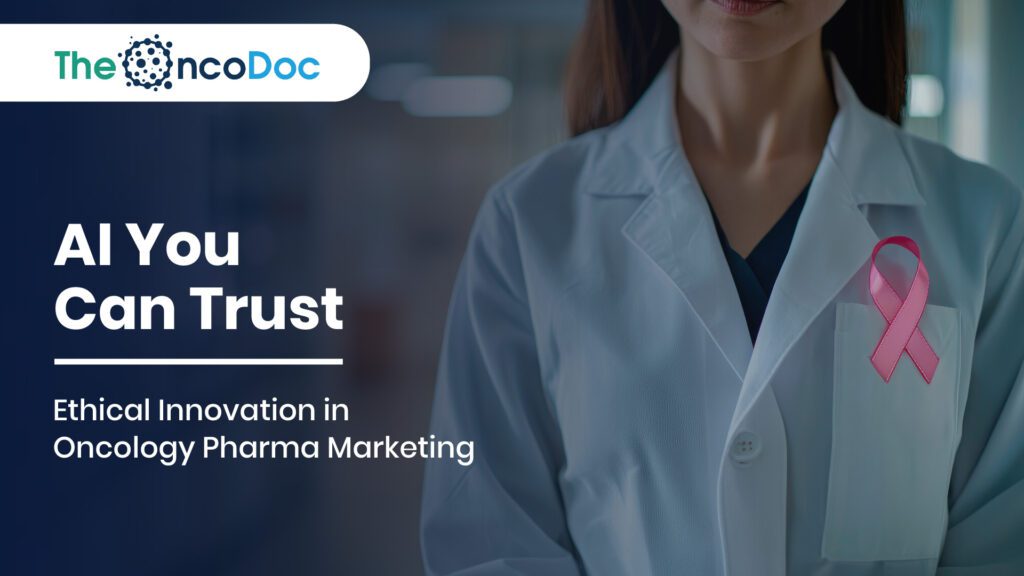Introduction: Ethics as the Cornerstone of AI-Driven Oncology Marketing
In oncology, where decisions carry profound consequences for patients and caregivers, ethical considerations are no longer a secondary thought, they are the foundation of every innovation. As pharmaceutical marketing integrates artificial intelligence (AI) to drive personalization, predictive campaigns, and precision engagement, the demand for responsibility and transparency has never been greater. AI’s power to analyze patient data, predict disease trends, and shape messaging offers unprecedented opportunities, but it also raises serious questions around privacy, consent, fairness, and explainability.
For oncology marketers, success no longer hinges solely on brand visibility or prescription numbers; it is measured by how campaigns respect patient rights, safeguard sensitive data, and enhance trust in a field already laden with fear and uncertainty. AI adoption in pharma is accelerating, but without strong ethical frameworks, regulatory compliance, and explainable systems, its promise risks being undermined by skepticism and misinformation.
This article explores how oncology pharma marketers can harness AI’s full potential responsibly, with a focus on transparency, Explainable AI (XAI), and ethical data practices. It also introduces strategies for creating marketing systems that meet regulatory demands while prioritizing empathy, equity, and trust.
1. Explainable AI: The End of the Black Box
AI models are powerful but often opaque. In oncology, where algorithms recommend therapies, predict cancer risks, or identify underserved populations, this opacity can lead to hesitation from healthcare professionals (HCPs) and regulators. Enter Explainable AI (XAI), which enables users to understand the “why” behind a model’s prediction.
XAI is not merely a technical trend; it’s a moral and regulatory necessity. Imagine an AI model that predicts a patient’s likelihood of non-adherence to cancer treatment. Without understanding its rationale, doctors and marketers cannot confidently act on its insights. XAI solves this by breaking down features influencing predictions, such as socioeconomic barriers, comorbidities, or digital engagement levels.
For oncology pharma marketers, XAI builds:
- HCP Confidence: Physicians trust insights they can validate.
- Patient Trust: Patients are more willing to share data when they understand its use.
- Regulatory Compliance: Global regulators increasingly demand algorithm transparency for medical devices and pharma solutions.
By embracing XAI, marketers signal that their commitment is not just to innovation but to ethical innovation.
2. Ethical Data Stewardship: Respecting Patient Autonomy
Data, screening results, genetic profiles, HCP prescription patterns, and patient-reported outcomes are all vital to oncology marketing. However, mishandling this data could erode public trust. Data ethics is no longer optional; it is a core pillar of pharma reputation.
Key Practices for Responsible Data Use
- Informed Consent 2.0: Beyond legal fine print, pharma marketers must adopt patient-friendly consent processes. Infographics, videos, and simple FAQs can explain how AI models use their information.
- De-Identification and Anonymization: Removing identifiable patient details before data analysis ensures that predictive campaigns cannot inadvertently expose sensitive information.
- Purpose-Driven Collection: Every data point must have a clear justification. Collecting only necessary data reduces risk and signals respect for patient autonomy.
Companies leading in ethical AI often implement patient-first governance boards to evaluate marketing practices, ensuring outreach aligns with both regulatory and moral standards.
3. Regulatory Compliance as a Competitive Advantage
Compliance with HIPAA (USA), GDPR (Europe), and India’s DPDP Act (2023) is essential, but companies that embrace compliance proactively, not reactively, gain a competitive edge. Oncology patients, who often feel vulnerable, prefer brands that emphasize privacy protection.
Forward-thinking marketers are:
- Embedding AI Audits: Routine checks ensure algorithms remain unbiased and compliant.
- Adopting “Privacy by Design”: Security elements are incorporated into AI systems from the very beginning.
- Offering Transparency Reports: Annual public reports showing data usage and privacy measures strengthen brand trust.
4. Algorithmic Bias: The Silent Threat in AI Marketing
In oncology, bias in AI can have disastrous results. If a dataset underrepresents rural cancer patients, AI campaigns may overlook entire communities, worsening disparities. For marketers, addressing bias is both a moral duty and a brand imperative.
Strategies to minimize bias include:
- Diverse Data Sets: Collecting data across genders, ethnicities, and geographies ensures inclusive messaging.
- Bias Testing: Regular algorithmic audits uncover hidden biases before campaigns go live.
- Community Collaboration: Partnering with NGOs and local health authorities helps capture underrepresented patient voices.
Bias reduction builds trust and expands reach, proving that ethics and profitability can align.
5. Building Patient Trust through Transparency
Trust is oncology marketing’s strongest currency. Patients must believe that every ad, chatbot, and screening reminder stems from ethical practices. Transparent AI practices make pharma brands partners in care rather than faceless corporations.
Key trust-building initiatives include:
- Open Algorithms: Sharing simplified models with patient advocacy groups.
- Clear Messaging on Data Use: Adding labels like “AI-generated” or “Data analyzed securely” to outreach content.
- Community Feedback Loops: Allowing patients to shape campaigns fosters inclusivity and trust.
6. Human-AI Synergy: Empowering Oncologists and Patients
AI cannot replace the empathy and judgment of oncologists; it can only augment them. Ethical oncology marketing emphasizes human-AI synergy: algorithms guide decisions, while humans deliver care.
Examples include:
- AI-Powered Clinical Dashboards: Help doctors track side effects and personalize treatment.
- Decision-Support Tools: AI identifies red flags, but doctors approve all recommendations.
- Marketing Personalization with Oversight: Campaign teams review AI-generated content to ensure sensitivity and cultural relevance.
7. Digital Ethics Boards and Governance
The complexity of AI in oncology marketing calls for new oversight structures. Digital Ethics Boards (DEBs), comprising ethicists, oncologists, patient advocates, and data scientists, are becoming a best practice.
Functions of DEBs:
- Reviewing AI campaign designs.
- Approving datasets for fairness and relevance.
- Auditing communication strategies for ethical alignment.
By creating these governance layers, pharma brands demonstrate their long-term commitment to responsibility rather than reactive compliance.
8. Explainability for Regulators and Payors
Explainability doesn’t just win patient trust; it also accelerates market access. Payers and regulators demand clarity on how AI tools determine campaign targets or predict patient adherence. XAI frameworks help pharma marketers:
- Gain faster approvals for AI-driven companion apps.
- Justify reimbursement strategies for digital therapeutics.
- Demonstrate risk-mitigation features to regulators.
This proactive approach aligns marketing teams with broader healthcare objectives, building credibility at every level.
9. Cybersecurity: Safeguarding Patient and HCP Data
Oncology marketing campaigns often integrate sensitive datasets from multiple sources, clinical trials, electronic health records, wearable data. This interconnectedness increases cybersecurity risks.
Modern marketers are investing heavily in:
- End-to-End Encryption: Protecting data across collection, analysis, and delivery.
- AI-Enhanced Threat Detection: Algorithms that spot security breaches before they escalate.
- Zero-Trust Architectures: Limiting access privileges for campaign teams.
A single breach can shatter years of trust-building; thus, cybersecurity is as integral to marketing as storytelling.
10. Responsible AI-Powered Personalization
Personalization can either delight or disturb patients, depending on how it’s implemented. In oncology, ethical personalization ensures that recommendations are empathetic and respectful.
Examples:
- Sending culturally appropriate awareness messages.
- Avoiding predictive content that could cause unnecessary anxiety (e.g., implying a high cancer risk without medical verification).
- Offering opt-out options for patients uncomfortable with AI-driven campaigns.
11. Ethical Storytelling: Balancing Emotion and Science
Oncology campaigns often rely on survivor stories, emotional visuals, and urgent calls to action. While effective, emotional marketing can sometimes border on fear-mongering. Ethical storytelling balances empathy with scientific accuracy, ensuring that emotional content empowers patients instead of overwhelming them.
Best practices include:
- Partnering with medical reviewers to validate all campaign narratives.
- Sharing survivor stories that emphasize hope and resilience.
- Avoiding exploitative visuals or language.
12. Equity in AI-Driven Marketing
Healthcare inequity remains one of oncology’s greatest challenges. AI has the potential to either exacerbate or lessen existing inequalities. Ethical marketing ensures that AI serves all communities, not just tech-savvy or affluent populations.
Approaches include:
- Training algorithms on multilingual datasets.
- Running awareness campaigns in rural clinics with low-tech delivery methods.
- Offering free or subsidized AI-driven screening tools in underserved areas.
This approach turns AI from a luxury into a universal healthcare enabler.
13. Building Trust Through Transparent Partnerships
Collaborations with NGOs, governments, and patient advocacy groups amplify credibility. Ethical partnerships signal that pharma companies prioritize societal impact alongside profits.
For instance, working with local health ministries to deliver AI-supported cancer awareness campaigns not only boosts outreach but also demonstrates accountability.
14. Continuous Ethical Training for Marketing Teams
AI ethics isn’t just a tech challenge; it’s a human one. Pharma marketing teams need regular training on:
- Recognizing ethical dilemmas in campaign design.
- Understanding bias risks in algorithm development.
- Practicing cultural sensitivity in AI-driven outreach.
This ensures every employee becomes an advocate for responsible AI.
15. Future Vision: The Rise of “Ethical by Design” Marketing
The future of oncology pharma marketing lies in making ethics invisible yet omnipresent, baked into every strategy from day one. Ethical AI won’t be an afterthought; it will be the default. Campaigns will use XAI, privacy-first analytics, and equity-focused messaging to ensure that innovation and responsibility evolve hand in hand.
16. Patient-Centric Consent Management Systems
As AI becomes deeply embedded in oncology marketing campaigns, dynamic consent models are emerging as a gold standard. Unlike traditional one-time consent, dynamic consent gives patients ongoing control over how their data is used.
These systems allow patients to:
- Adjust their data-sharing preferences in real time.
- Receive updates on how their data fuels research or awareness campaigns.
- Opt in or out of AI-powered personalization at any stage.
Dynamic consent platforms foster shared decision-making and strengthen brand credibility. Patients feel empowered rather than exploited, transforming marketing from a transactional activity into a transparent partnership.
17. The Role of Digital Twins in Ethical Marketing
Digital twins, virtual models that simulate individual patient health journeys, are becoming invaluable for predicting outcomes and tailoring educational campaigns. Strict ethical control is necessary to balance their authority, though.
In oncology marketing, ethical applications of digital twins include:
- Therapy Simulation Education: Helping patients visualize potential treatment pathways before committing.
- Predictive Health Insights: Offering general risk awareness without causing unnecessary alarm.
- Privacy-Protected Modeling: Using aggregated data to ensure anonymity while enabling accuracy.
Digital twins show how AI-driven personalization can be both innovative and ethically sound, offering value without compromising privacy.
18. Inclusive Marketing through AI Accessibility Tools
Responsible AI also addresses accessibility challenges. Many oncology patients face barriers such as visual impairments, language differences, or cognitive fatigue from treatment. Marketing strategies are now integrating AI-powered accessibility solutions:
- Text-to-Speech Features for educational campaigns.
- Voice Assistants in multiple regional languages for rural outreach.
- Simplified Reading Levels using natural language processing (NLP) to rewrite complex oncology terms.
These inclusivity-driven innovations ensure no patient is left behind, reinforcing pharma’s ethical mission of equity in care delivery.
19. Ethical Metrics for Measuring Success
Traditional KPIs like engagement rates and lead conversions fall short of capturing ethical success. Oncology pharma marketing is moving toward impact-driven metrics that evaluate societal benefit:
- Number of screenings booked because of AI-driven reminders.
- Reduction in misinformation exposure through social listening campaigns.
- Growth in patient confidence scores measured through sentiment analysis.
By embracing these metrics, marketers prove that ethical impact and commercial success can coexist. Brands that prioritize long-term trust over short-term sales create deeper patient loyalty.
20. Collaboration with AI Ethics Researchers
A critical yet often overlooked strategy is direct collaboration between pharma marketers and AI ethics researchers. This cross-disciplinary partnership ensures campaign strategies undergo rigorous ethical scrutiny.
These collaborations offer benefits such as:
- Algorithm Transparency Reviews: Independent audits build credibility.
- Bias Reduction Strategies: Insights from ethics experts help correct systemic data biases.
- Patient-Centric Innovation: Ethical frameworks designed in tandem with marketing campaigns.
Partnering with external ethics researchers demonstrates commitment to accountability and aligns oncology pharma marketing with global standards of responsible AI development.
Conclusion
With these additional considerations, patient-driven consent, ethical digital twin usage, accessibility initiatives, impact-focused KPIs, and partnerships with AI ethics experts, oncology pharma marketing is evolving into a field where trust, transparency, and innovation intersect seamlessly.
These strategies move beyond regulatory box-ticking and create a patient-first marketing ecosystem that anticipates risks while leveraging technology responsibly. In a sector where life-altering decisions hinge on trust, ethical AI is no longer a competitive differentiator; it is a non-negotiable foundation for long-term success.
The Oncodoc team is a group of passionate healthcare and marketing professionals dedicated to delivering accurate, engaging, and impactful content. With expertise across medical research, digital strategy, and clinical communication, the team focuses on empowering healthcare professionals and patients alike. Through evidence-based insights and innovative storytelling, Hidoc aims to bridge the gap between medicine and digital engagement, promoting wellness and informed decision-making.



